August 15-September 26, 2025
Bizen Pottery
On our way from Hiroshima to Kyoto, we stopped at a pottery shop/studio in Bizen and learned about Bizen-yaki, also known as Bizen ware. It is one of the oldest and most revered forms of Japanese ceramics and this shop has been going for ten generations. The history of this pottery spans over a thousand years. Originating from Bizen Province in Okayama Prefecture, this unique, unglazed pottery represents a profound connection between the earth, fire, and human craftsmanship. For tea practitioners and connoisseurs of Japanese aesthetics, Bizen-yaki is not only a vessel but a philosophy.
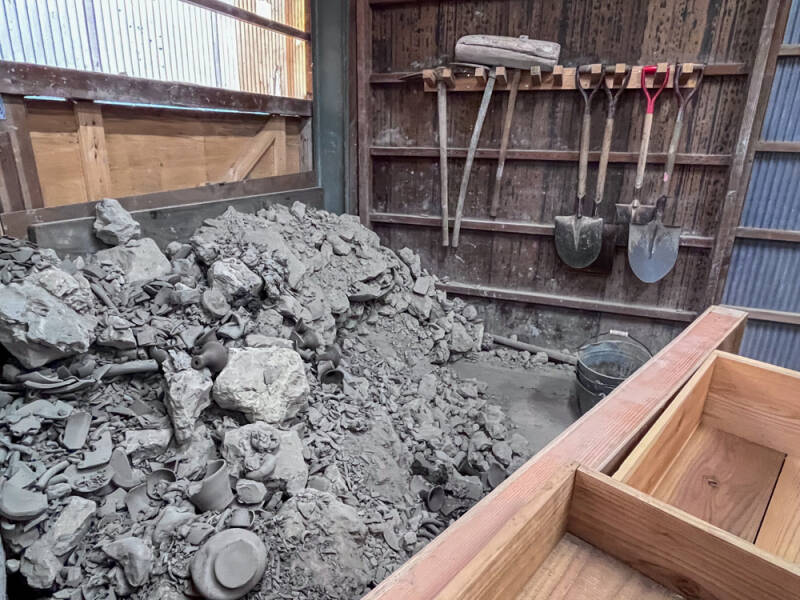
The clay is difficult to get and is taken from beneath the rice fields in the local area.

This gentleman, a Korea-American, married his Japanese wife and therefore a tenth-generation potter. He moved to Japan, with his wife, to learn the craft. These are the wood fired kilns. See the wood in the background? All ten tons of it will be used in the single two-week firing.

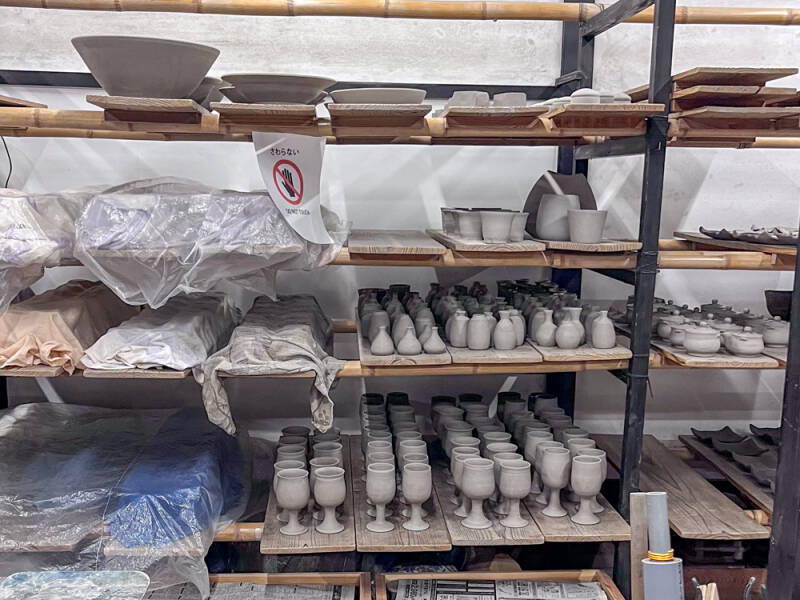
Up to 4,000 pieces are then made throughout the year in preparation for the single two-week firing, usually done in spring.
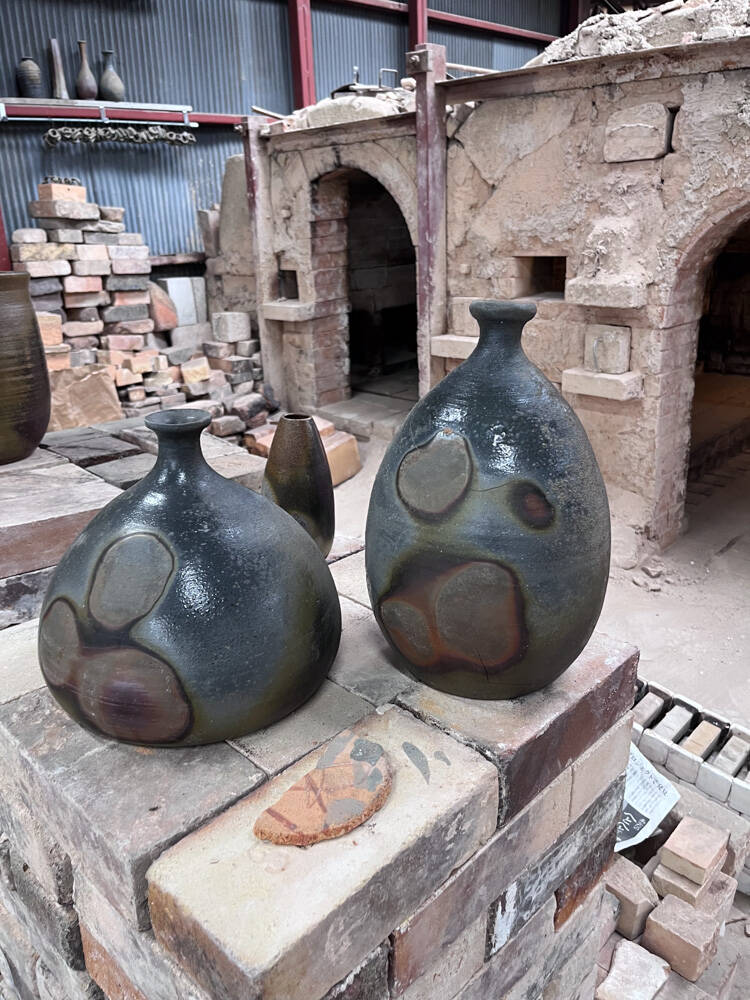
Pieces are placed in the kilns, stacked upon each other and around the wood. It is an unglazed finish but still holds liquid. The colors come from the differing heat within the kiln. The darker pieces are colored by melted ash, the round spots are where pieces touched each other. Each piece is different and unique and one never knows what will survive. The holes in the kiln are where the 24/7 crew tosses in the wood, knowing some pieces will break, but keeping it at the desired temperature. Lower in the coals is hotter and higher placed pieces are in "cooler" temps.
Buddah Statues
Buddhism was first established in Japan in the 6th century CE. Most of the Japanese Buddhists belong to new schools of Buddhism which were established in the Kamakura period (1185-1333). During the Edo period (1603–1868), Buddhism was controlled by the feudal Shogunate. The Meiji period (1868–1912) saw a strong response against Buddhism, with persecution and a forced separation between Buddhism and Shinto.
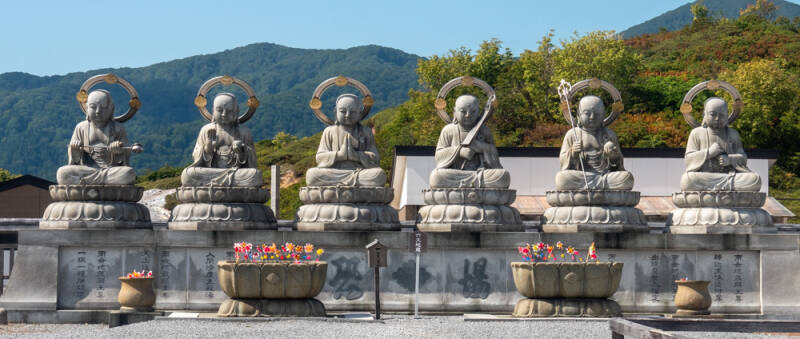
In Buddhism, there are six main Buddhas that are considered to be the most important figures in the religion. These Buddhas are known for their teachings, enlightenment, and guidance for followers on the path to spiritual awakening. Each Buddha represents a different aspect of enlightenment and wisdom, and their stories are often used as a source of inspiration for Buddhists around the world.

This statue, located at Seiryuji Temple in Aomori City, was constructed in 1984 and is the largest seated bronze Buddha statue in Japan.
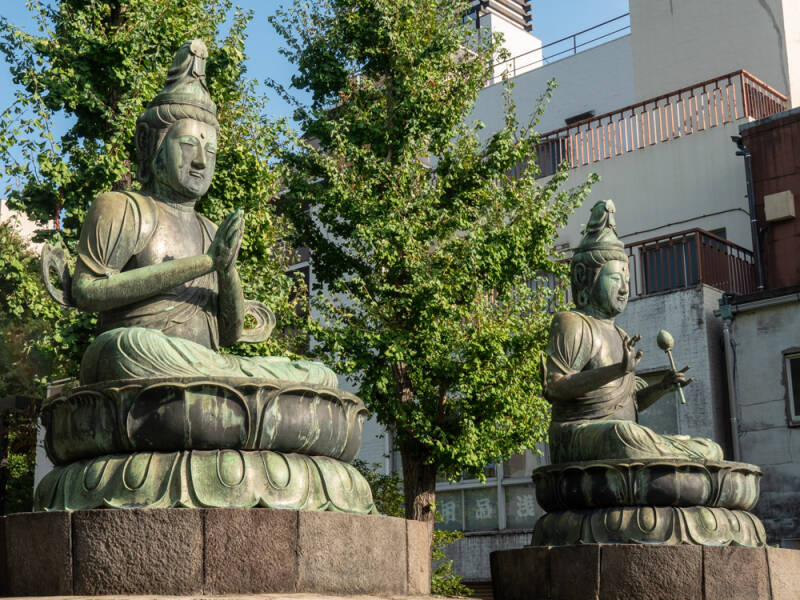
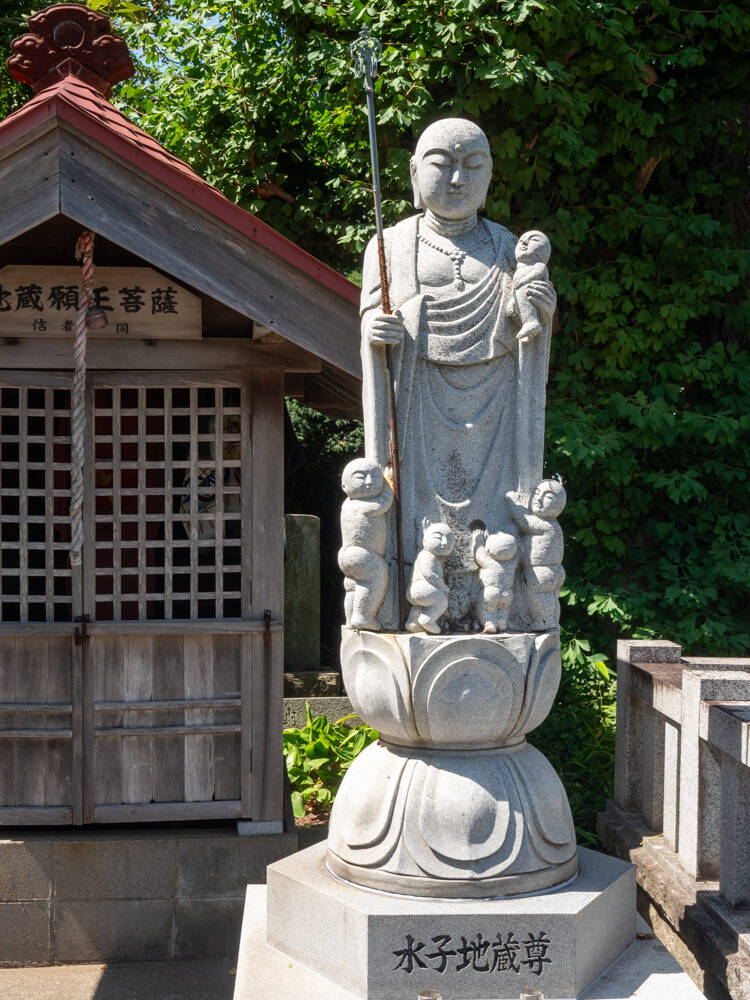
The Standing Buddha is a significant representation in Buddhist art, symbolizing the Buddha's readiness to teach and share his wisdom.
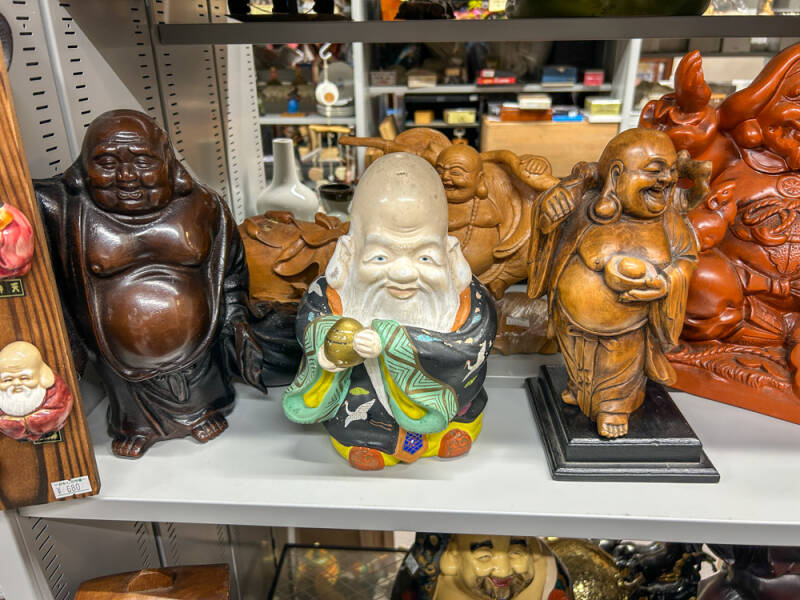
We also found many Buddhas in thrift stores. They tended to be pot bellied, jolly looking characters.
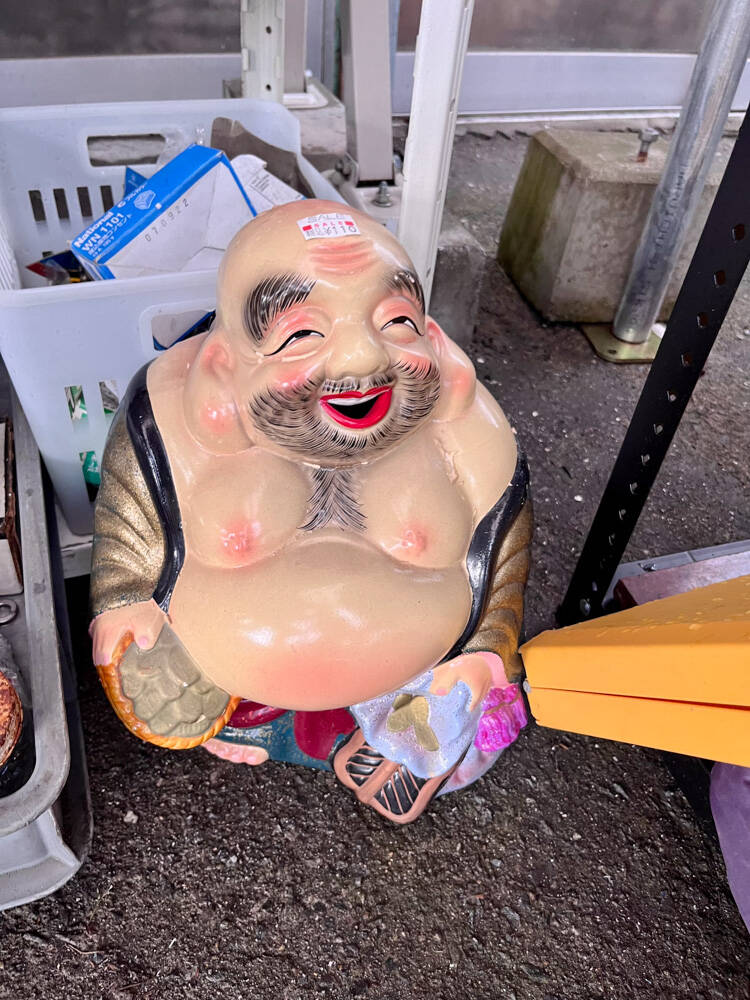

The Seated Buddha embodies several key concepts in Buddhism:
- Meditation and Enlightenment: The seated position represents the Buddha's attainment of Nirvana under the Bodhi tree, emphasizing the importance of meditation in achieving spiritual insight.
- Teaching: Many seated Buddha statues are depicted with hand gestures (mudras) that convey specific teachings, such as the Dharmachakra Mudra, symbolizing the turning of the Wheel of Dharma.
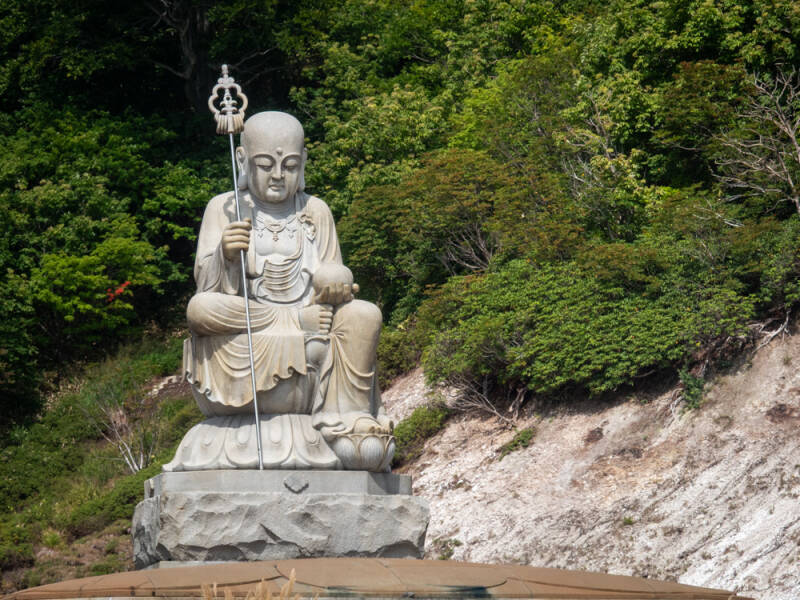
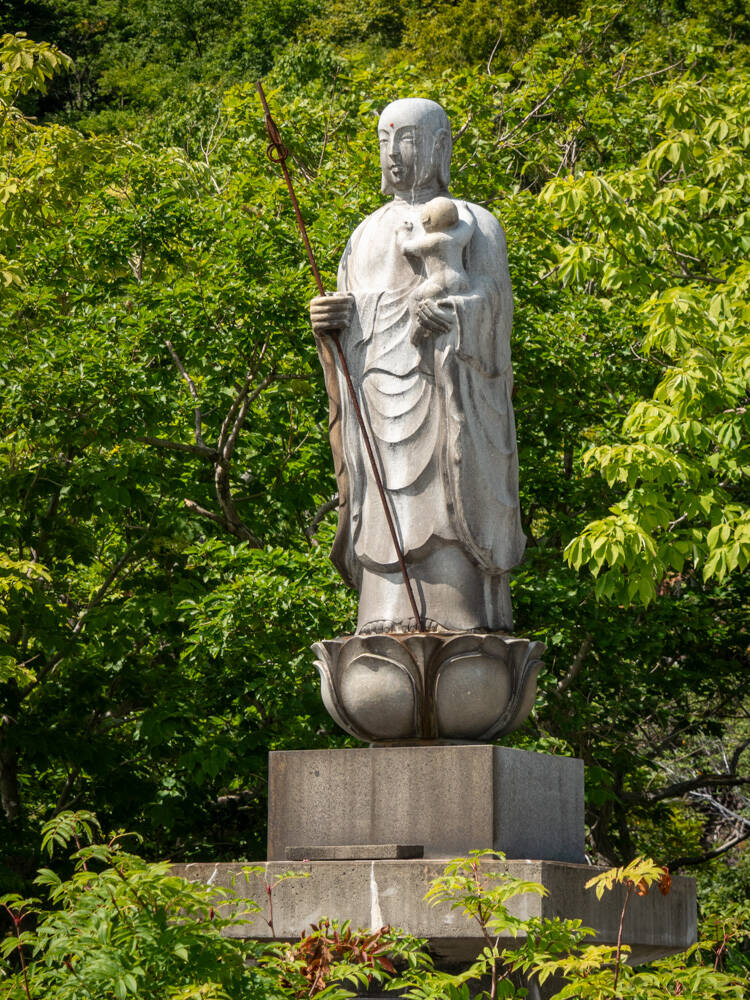
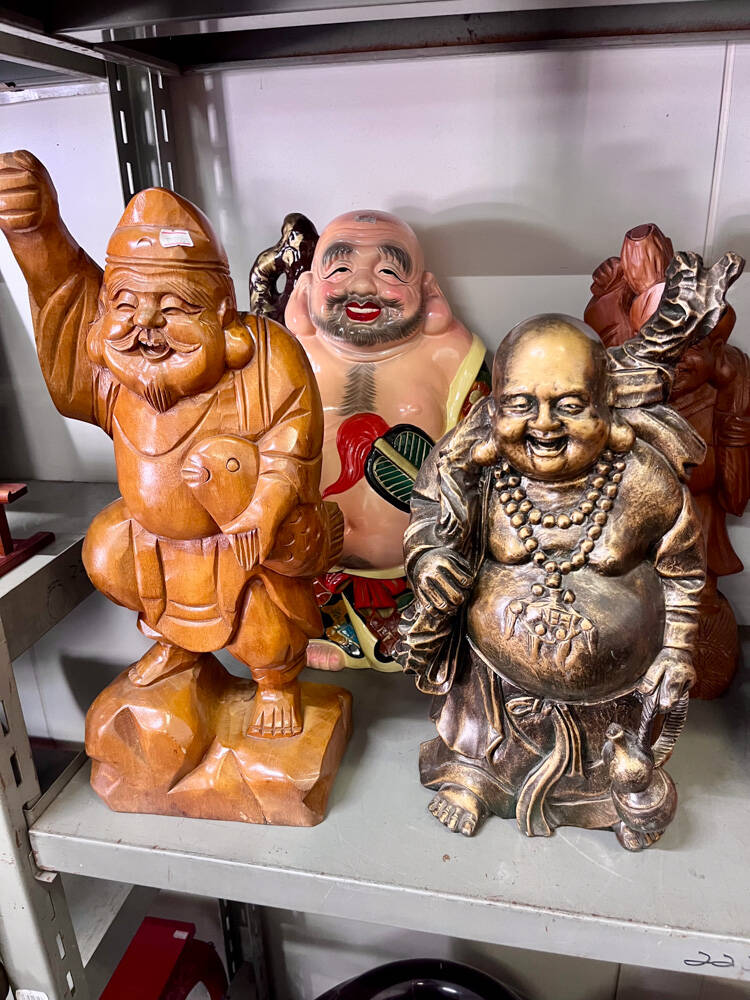
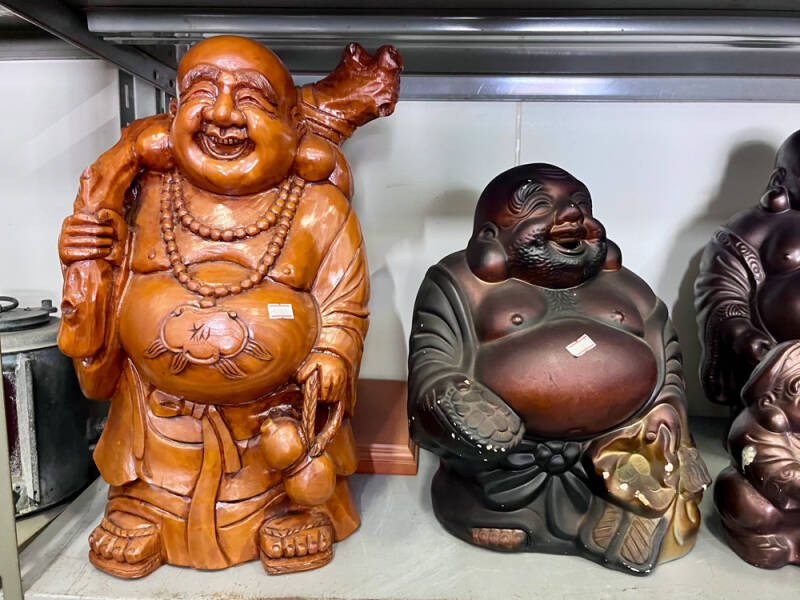
Festival Floats
There are many Japanese festivals in which the kami (deities) are prayed to for a good harvest of rice and other crops. In agricultural festivals, different ceremonies are held in each of the four seasons. In general, festivals held in the spring pray for a good harvest for the year, festivals held in the summer pray for rice and crops to be free from pests and storm damage, festivals held in the fall offer gratitude for the harvest, and festivals held in the winter pray for a good harvest in the new year. Based in Shinto and Buddhism, these floats represent not only the spirits that inhabit all things and the souls of their ancestors, but also terrifying and violent gods and spirits that protect the people from epidemics and natural disasters.


Our first weekend in Misawa, Japan found us at the Misawa Festival, the last of the summer festivals. In the above images I want you to notice the power lines along the street. The floats are built to go through these streets, however, as they turn left and come down the street one block over there ARE no low power lines and the floats have sections that raise up and become tall.

It is my understanding that each of the neighborhoods in Misawa creates a float based on the deities worshipped in their local shrines and temples.
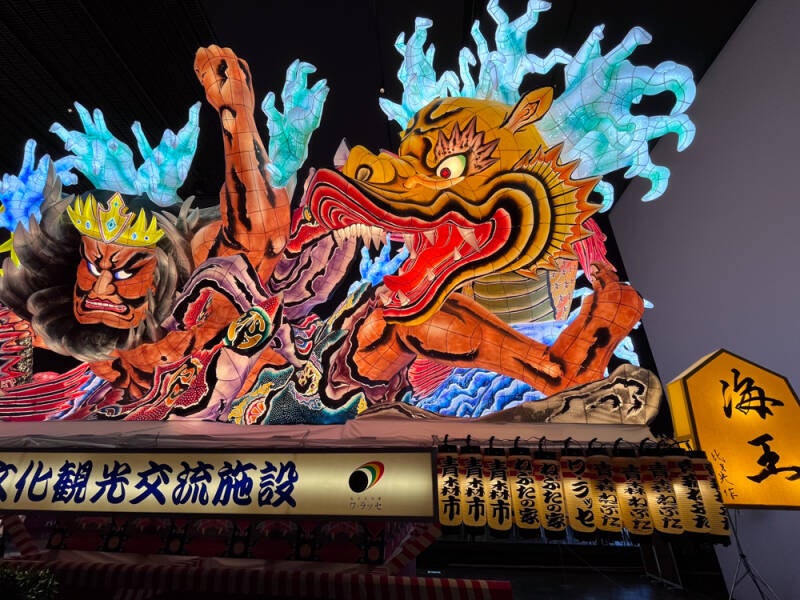
It takes the neighborhoods all year to design and build their floats. When you look at the detail you can see why.

Hachinohe Horses
Wooden horse figures called Yawata-uma (also Hachinohe horse) have been made for 700 years. The horses are often given at celebrations as they are believed to bring good luck.


We found these two sets of horses in local thrift shops in Aomori Prefecture.
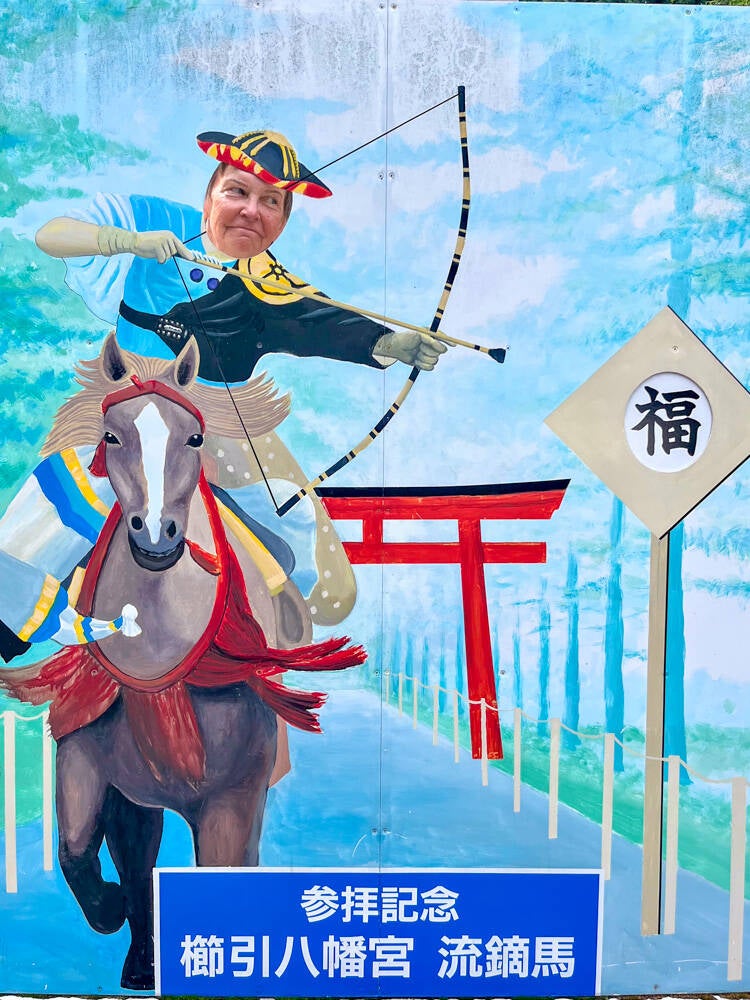
This is Ellen participating in the ancient art of Yabusame. Yabusame is a type of mounted archery where the archer, on a running horse, shoots three special "turnip-headed" arrows successively at three wooden targets along a path. This style of archery has its origins at the beginning of the Kamakura period (1192-1333) when a local leader became alarmed at the lack of archery skills his samurai possessed. He organized yabusame as a form of practice.
Teniya, the daughter of our hosts for the month, competes in Yabusame and is really good! Unfortunately, we didn't have the opportunity to watch her in a competition. And Kamalene, her mom, has also taken up this activity.

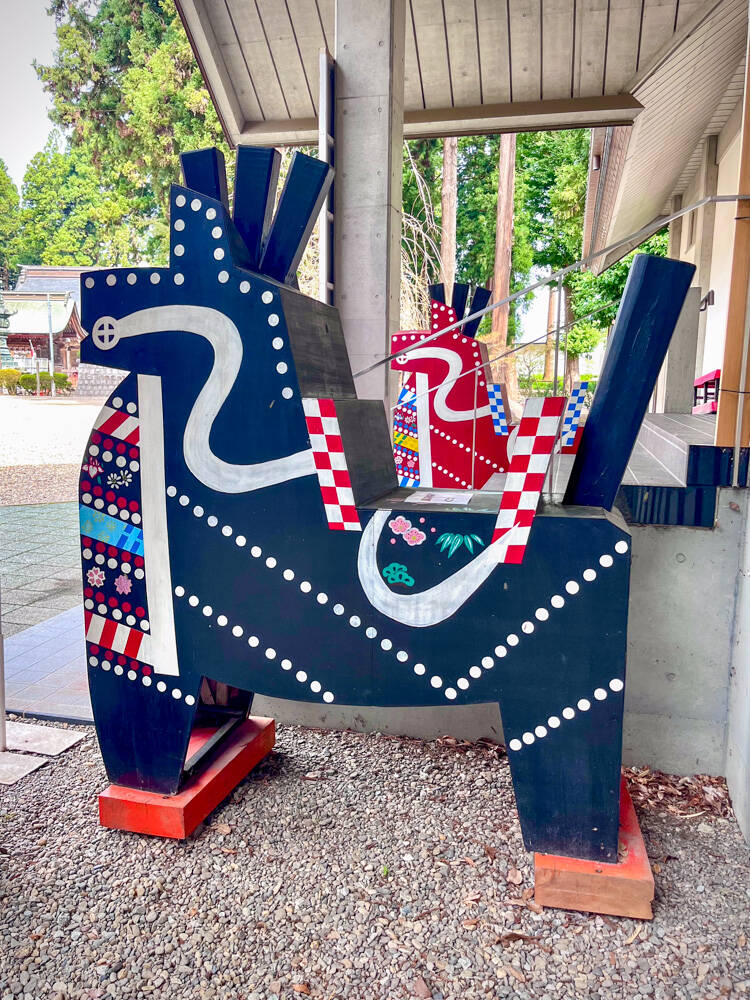
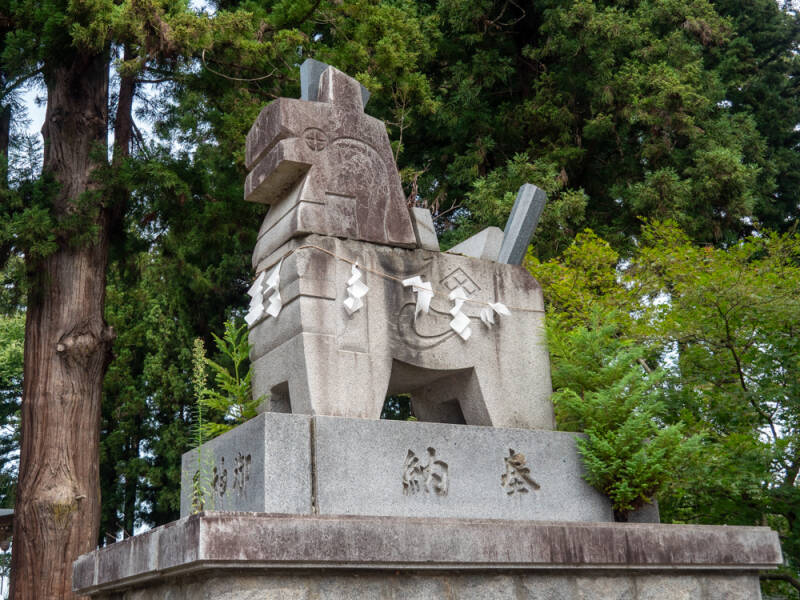
These horses were found at Kushihiki Hachimangū, a Shinto shrine located in Hachinohe, Aomori Prefecture, Japan. It is a Hachiman shrine, dedicated to the kami Hachiman. The shrine was established between 1190-1199. Teniya had just done her final Yabusame competition at this shrine the weekend before we arrived. We were bummed to have misssed it.
Kokeshi Dolls
Kokeshi dolls are traditional Japanese wooden dolls that are often seen as symbols of good fortune, protection, and a wish for a child's growth. Originating from the Tohoku region, these dolls are handcrafted and painted, reflecting the artistry and cultural heritage of Japan. Historically, they were created to provide wrmth and comfort to children, and they have evolved into cherished folk art collectibles.






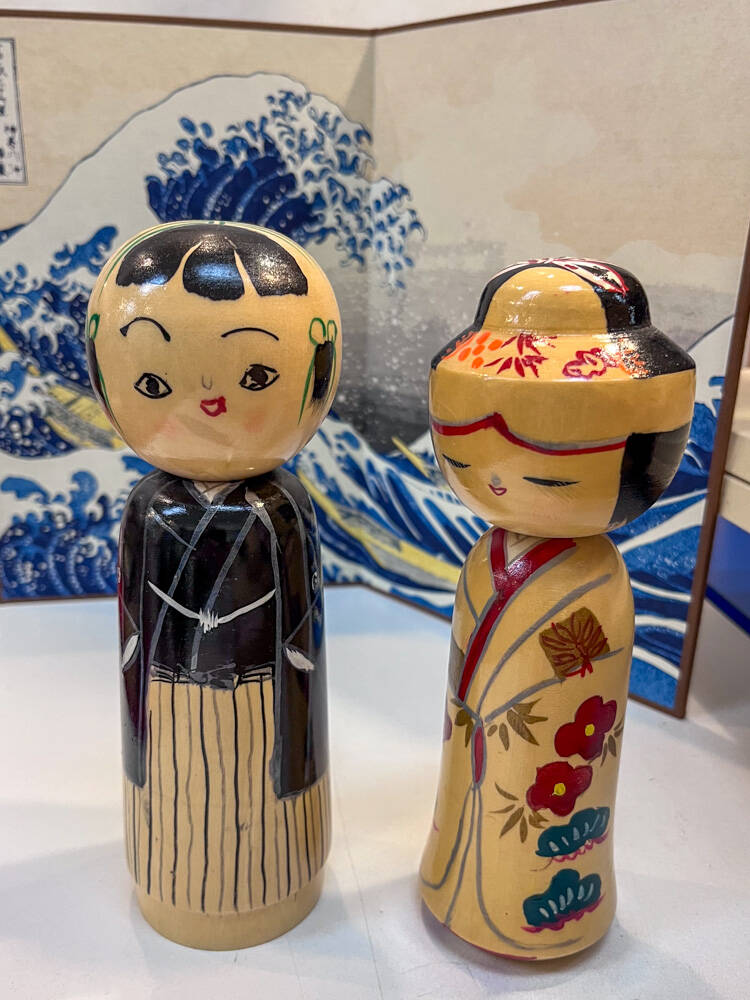


We found these in a thrift store. The ones above seem to be from a country other than Japan, yet have similar characteristics. The ones to the left with their pointed heads...still Kokeshi?
Murals
Murals
Many murals are painted on rolling metal shop doors.

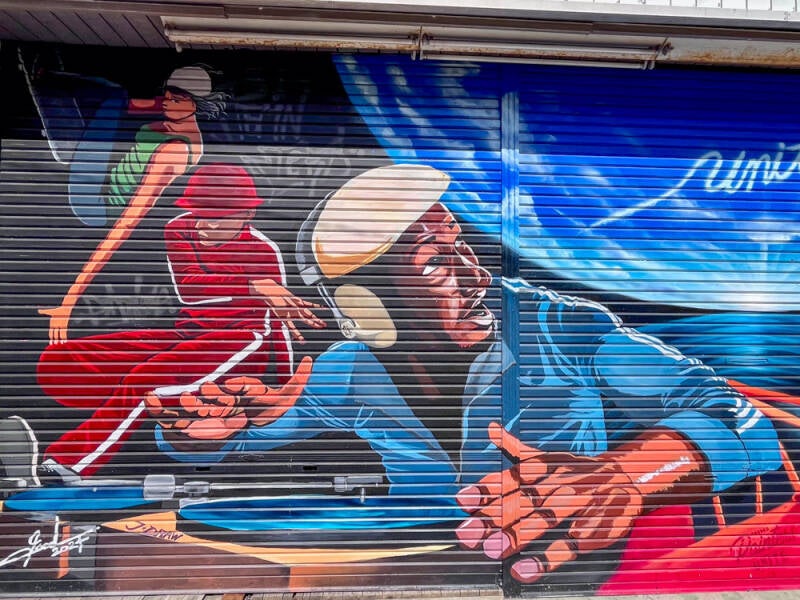
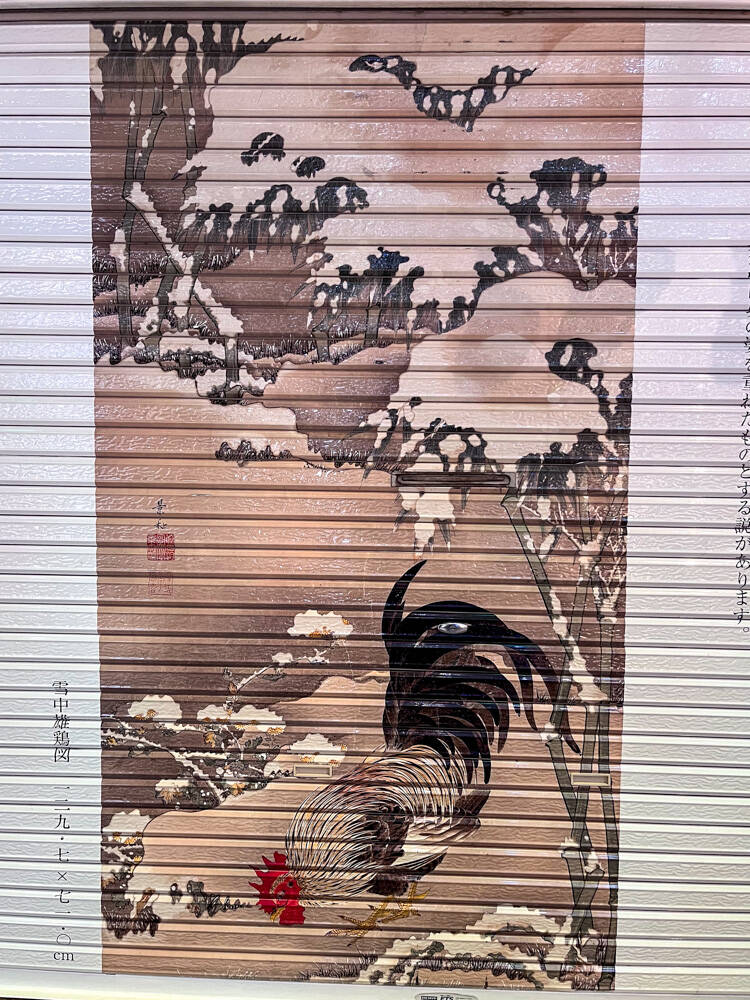
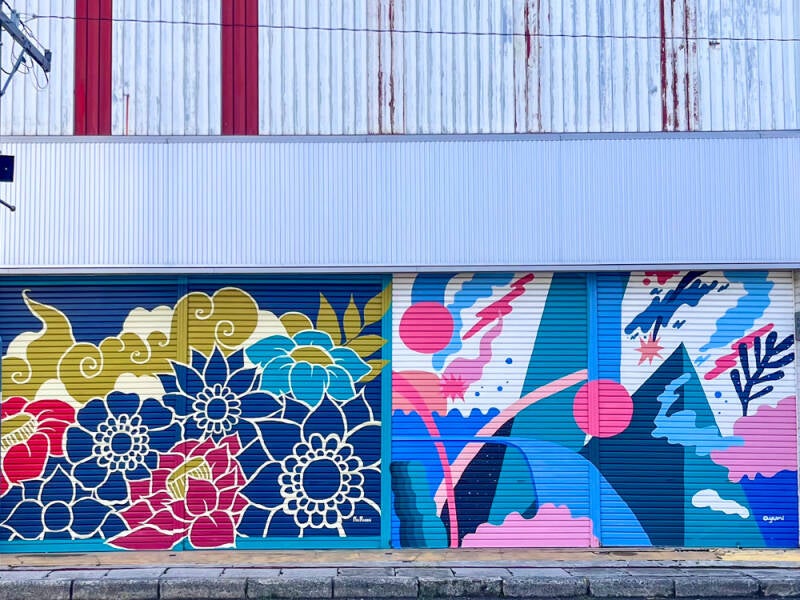




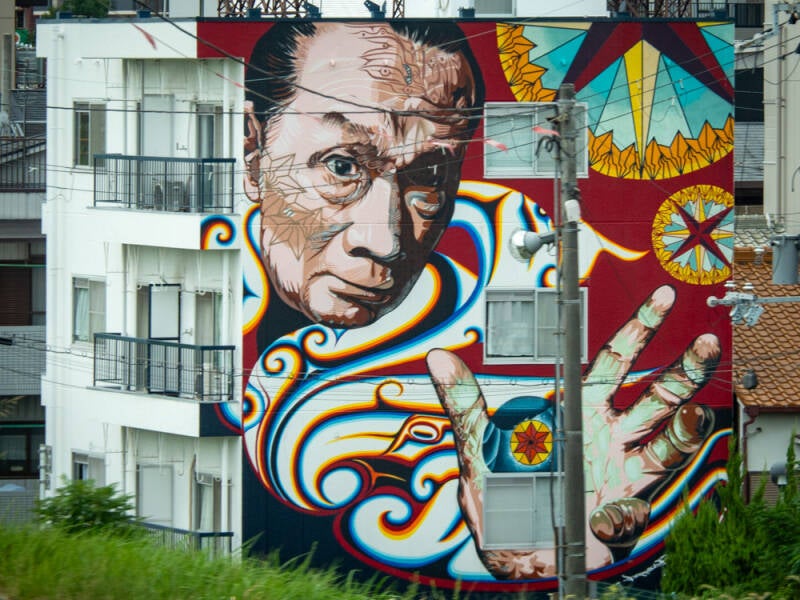
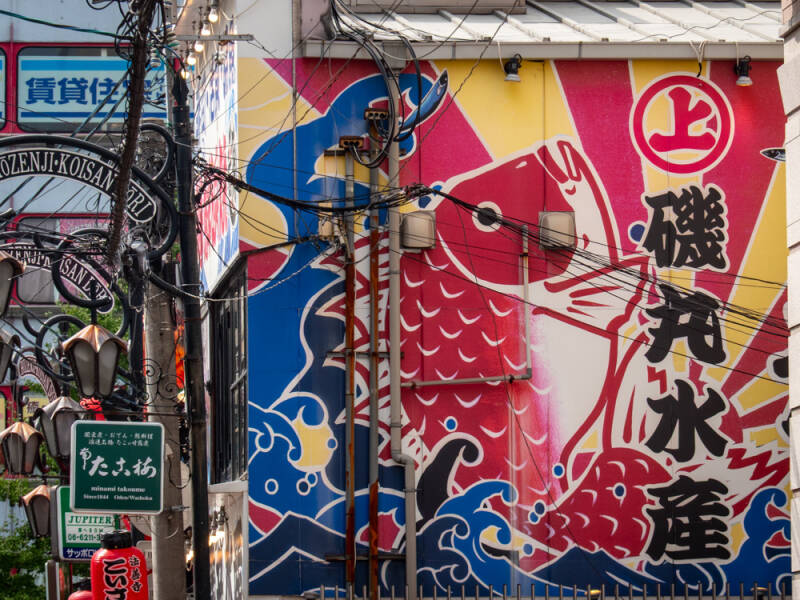

The sides of buildings.
The staircase at the Towada art center.
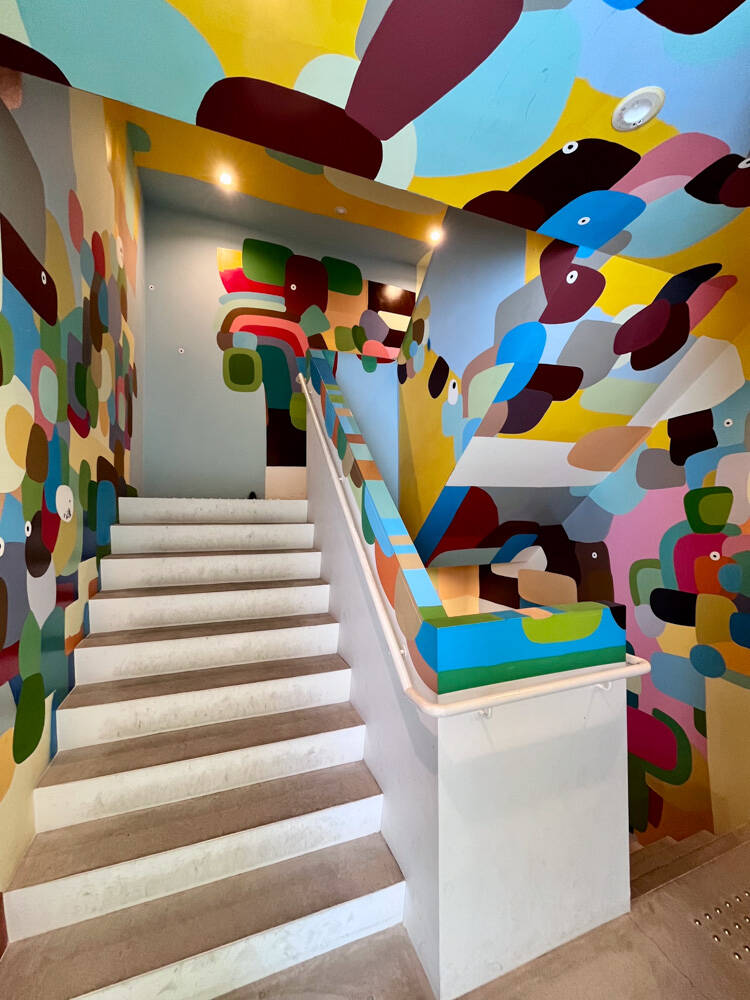
This was painted on the floor of the Towada Art Center in the town of Towada.


This was a large tile mosaic at the Old Outdoor Farmhouse Museum.
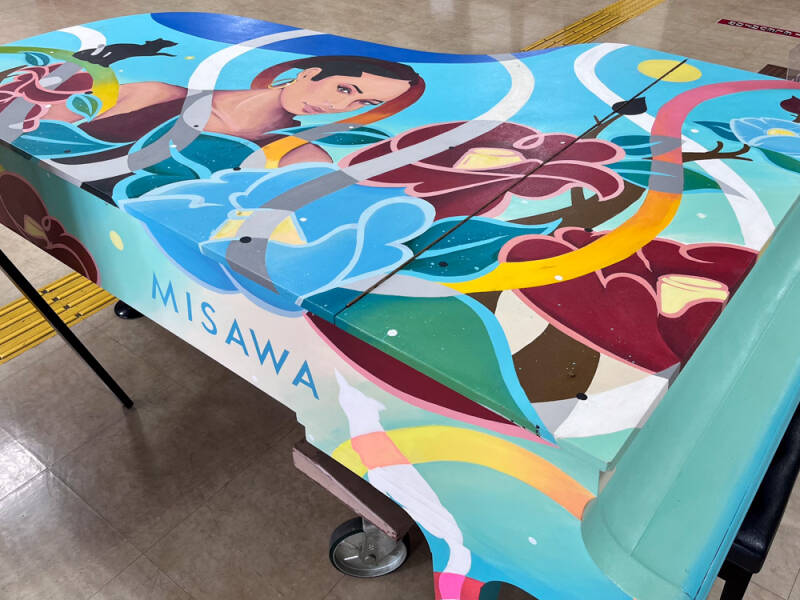
I'm not sure this is considered a mural either but I had to put it somewhere.
Music
Music was very prevalent at the temples and shrines in Japan as well as on the floats at the Misawa Festival.

We found this snake-skin instrument at a thrift store.
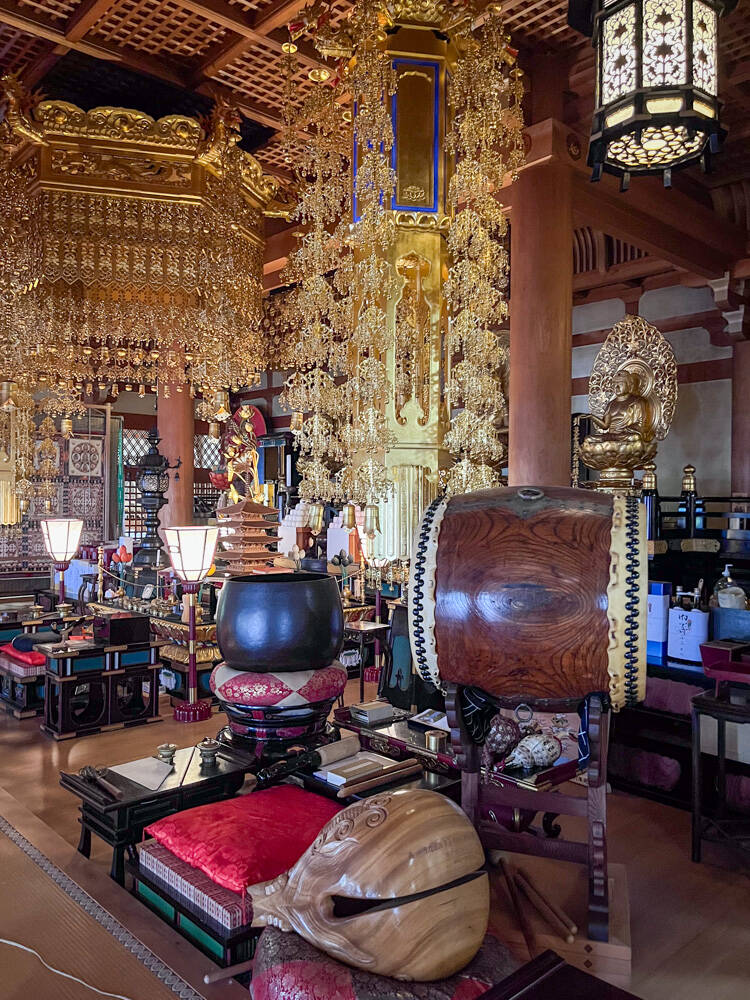
The innards of one of the Buddhist Temples and their musical instruments.

Bells were present at most shrines and temples. Less a musical instrument, more a way to summon the kami, or gods.
Suzu are round, hollow Japanese Shinto bells that contain pellets that sound when agitated. They are somewhat like a jingle bell in form, though the materials produce a coarse, rolling sound. Suzu come in many sizes, ranging from tiny ones on good luck charms to large ones at shrine entrances. Suzus are, however, classified as small bells, since big bells are referred to as kane. The former is associated with Shinto and shrines, while the latter is related to Buddhist temples and ceremonies.
At Shinto shrines, large suzu drape over entrances, as it is said that ringing them calls kami, allowing one to acquire positive power and authority, while repelling evil.

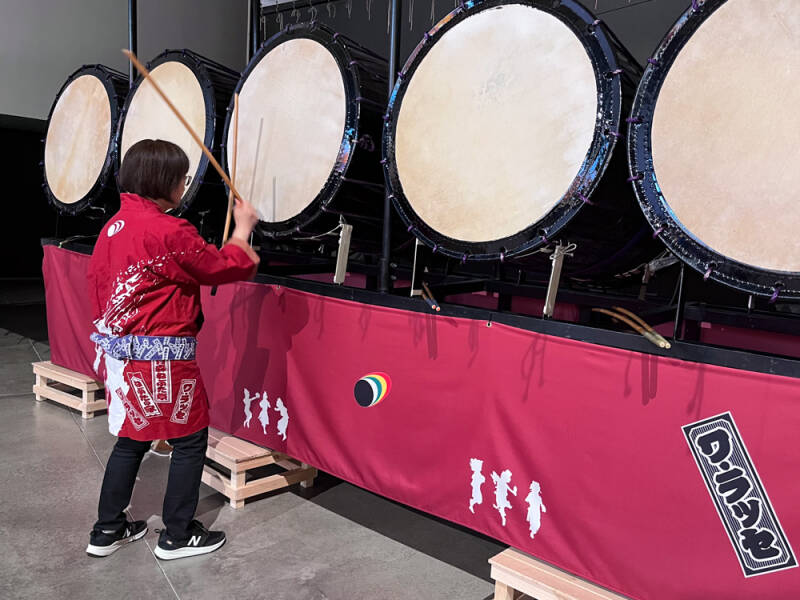
We got to beat on these drums after a brief lesson at the Nebuta Float Museum in Aomori City.
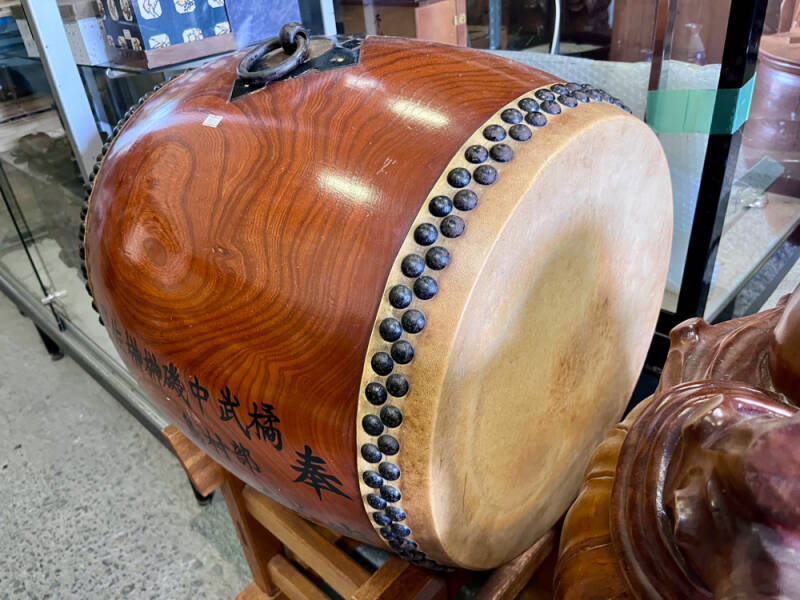
Taiko Drums have played an important role in many local festivals across Japan. They are also used to accompany religious ritual music. In kagura, a category of music and dances stemming from Shinto practices, taiko frequently appear alongside other performers during local festivals. In Buddhist traditions, taiko are used for ritual dances as part of the Bon Festival.

Kids chant, sing, yell and bang on their drums on a float at the Misawa Festival. Note the flute corps behind them.
One can purchase a drum from a thrift store.
Paintings
Paintings

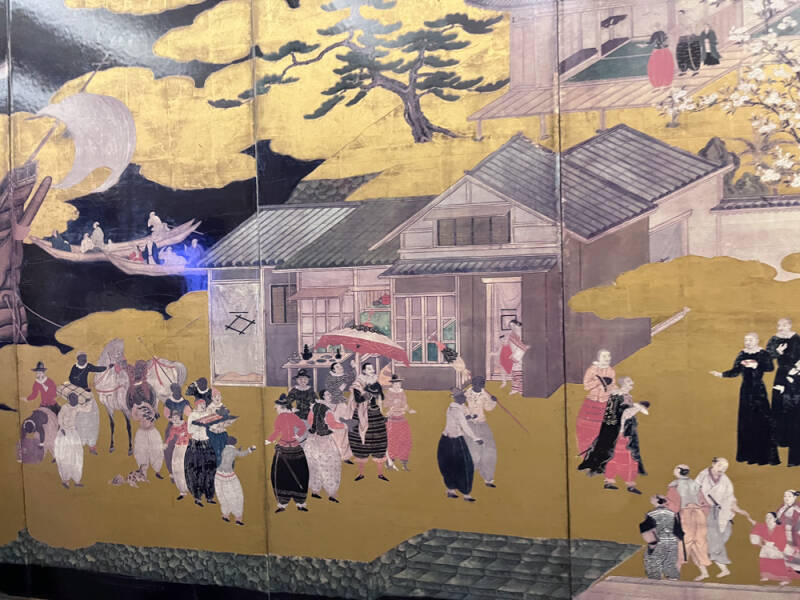
A painting in Osaka Castle.

These two paintings were on the walls of the Hoko-ji Temple in Nanbu. The one on the left was listed as heaven and the one above was labeled as hell.

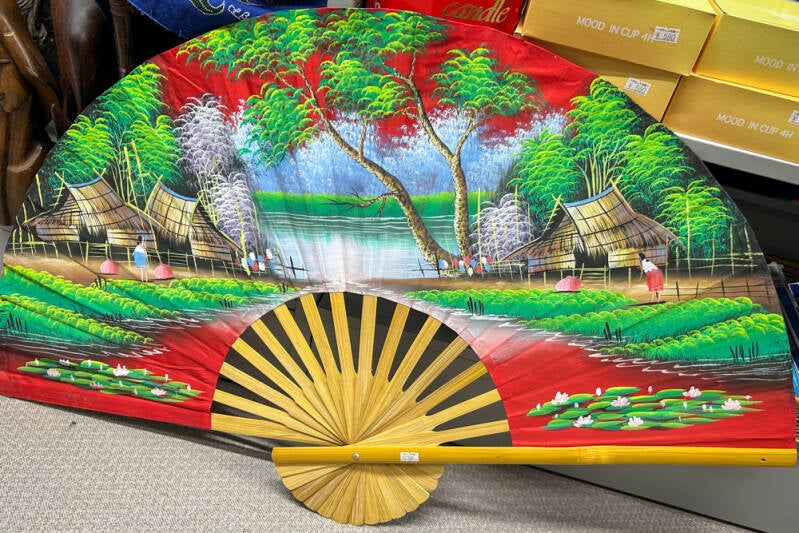
A painted fan at a thrift store in Kuroishi City, on our way to Hirosaki Castle.
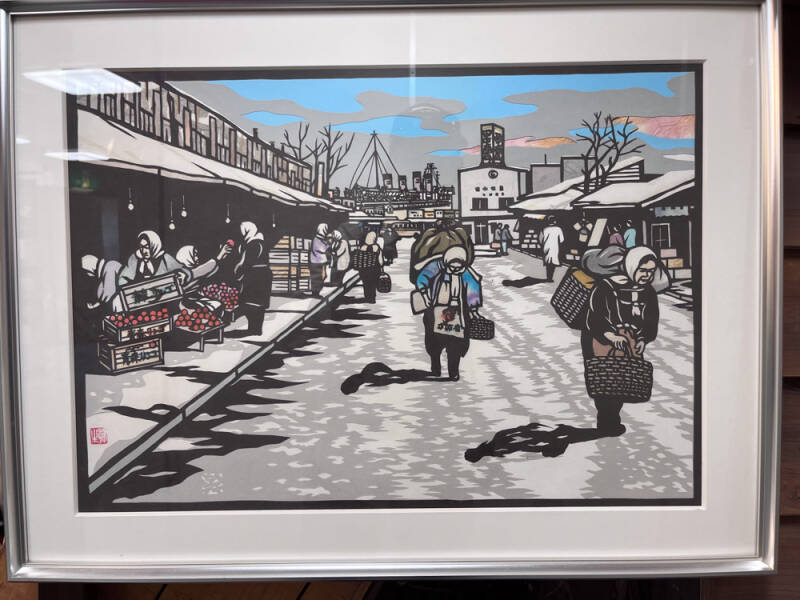
A painting from the Ferry Museum in Aomori City.
Another painting from the Hoko-ji Temple in Nanbu.

A painting of gods fighting in the Nebuta Float Museum in Aomori City.
Paper

Part of the Sadako Sasaki memorial in Hiroshima, the thousand paper cranes story.

In addition to being used for shade, oil-paper umbrellas are also traditional wedding items. In traditional Chinese and Japanese weddings, the matron of honor would cover the bride with a red oil-paper umbrella upon her arrival to ward off evil spirits. Purple umbrellas are a symbol of longevity for elders, while white umbrellas are used in funerals. Oil-paper umbrellas are also used as props in Japanese traditional dances and tea ceremonies.
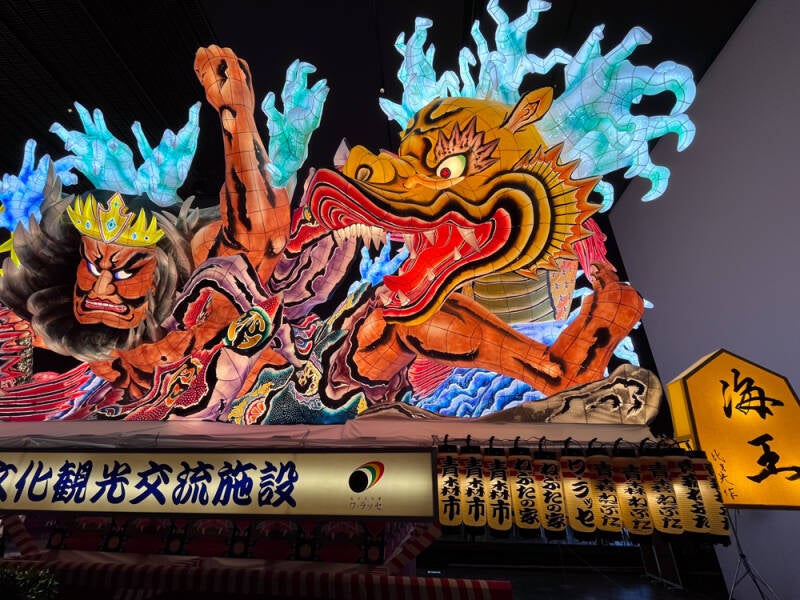
These float figures are made of wooden frames for structural support and wire for the detailed shaping and further support. These frames are then covered with washi paper, which is coated with paraffin to enhance shine and prevent ink leakage.
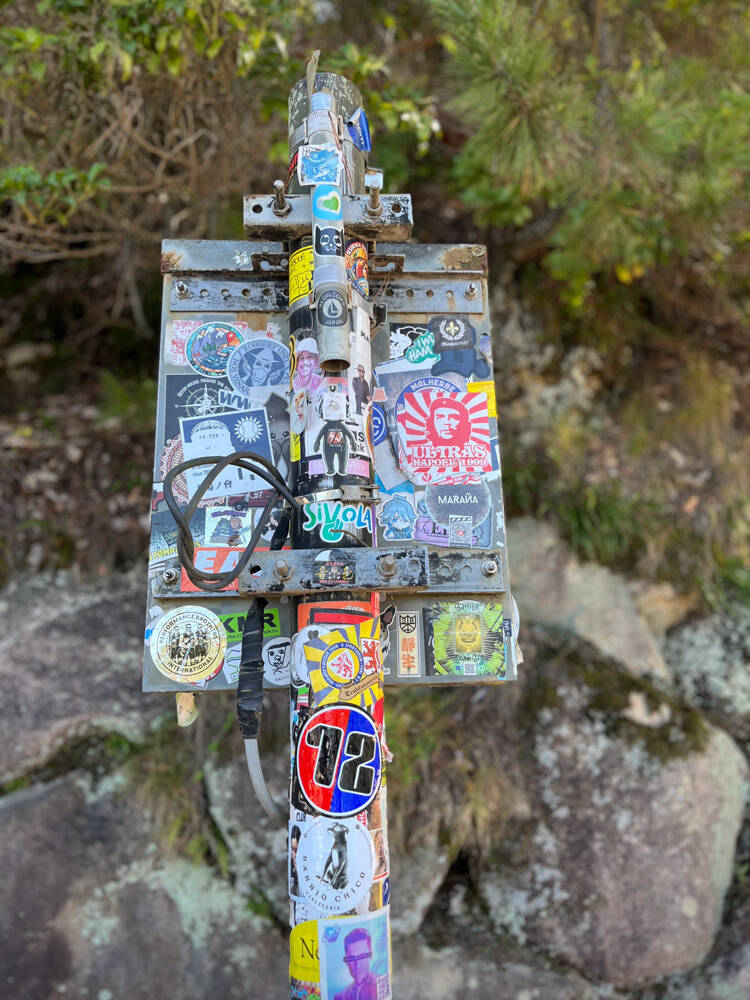
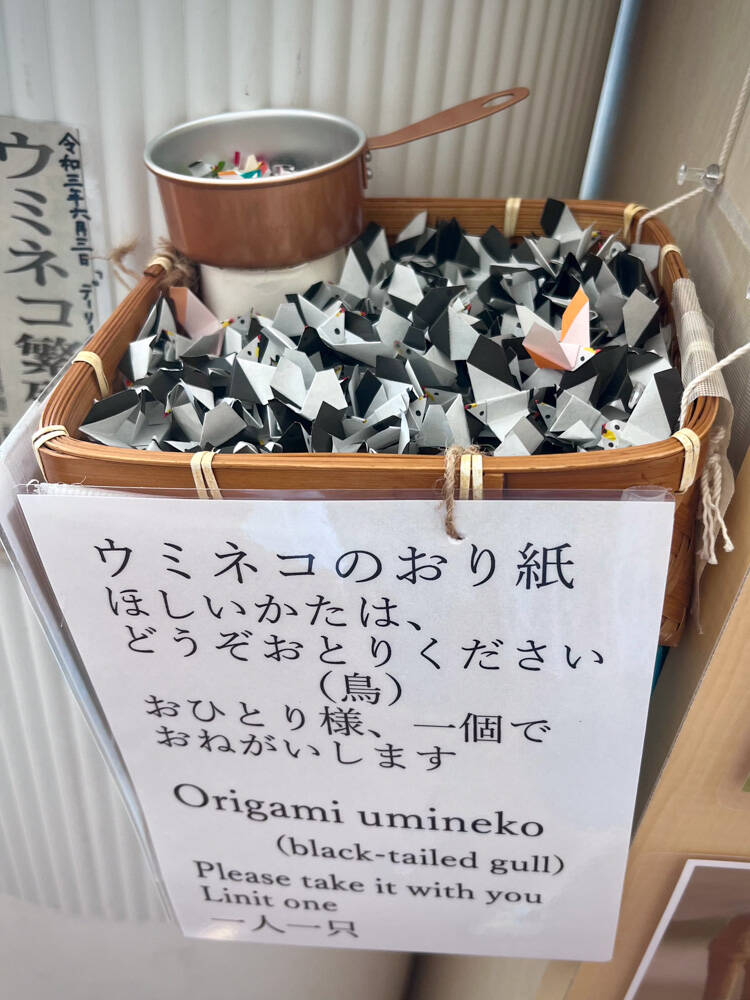
Origami is the Japanese art of paper folding. In modern usage, the word origami is often used as an inclusive term for all folding practices, regardless of their culture of origin. The goal is to transform a flat square sheet of paper into a finished sculpture through folding and sculpting techniques. Modern origami practitioners generally discourage the use of cuts, glue, or markings on the paper. Origami folders often use the Japanese word kirigami to refer to designs that use cuts.
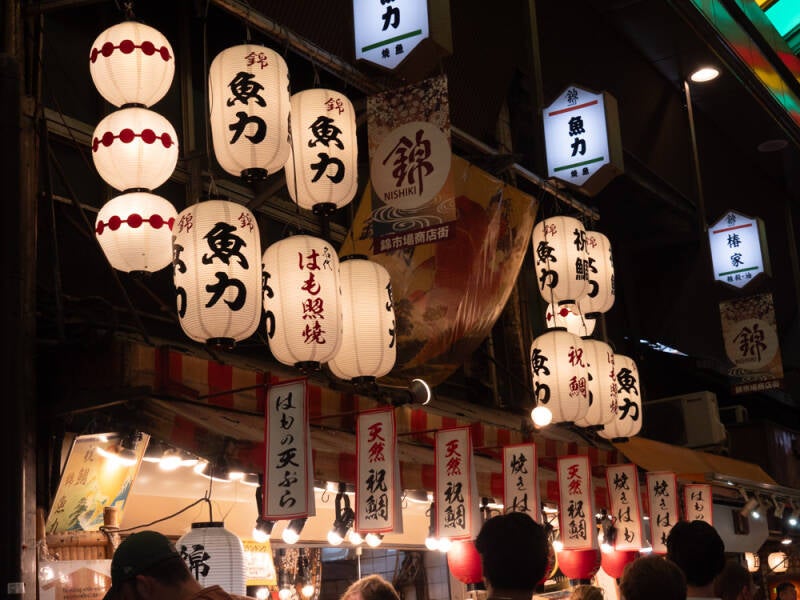
Paper lanterns are likely derived from earlier lanterns that used other types of translucent material, like silk, horn, or animal skin. The material covering was used to prevent the flame in the lantern from being extinguished by wind, while still retaining its use as a light source. Papermaking technology originated in China from at least AD 105 during the Eastern Han dynasty, but it is unknown exactly when paper became used for lanterns. Poems about paper lanterns start to appear in Chinese history around the 6th century. Paper lanterns were common by the Tang dynasty (AD 690–705), and it was during this period that the first annual lantern festival was established. From China, it spread to neighboring cultures in East Asia, Southeast Asia, and South Asia.

Stickers on signs or poles was a rare sight, as was graffiti.
Prayer Plaques
I covered prayer plaques in my last blog post, Animals. Here is a collection of non-animal plaques we found at various shrines and temples.
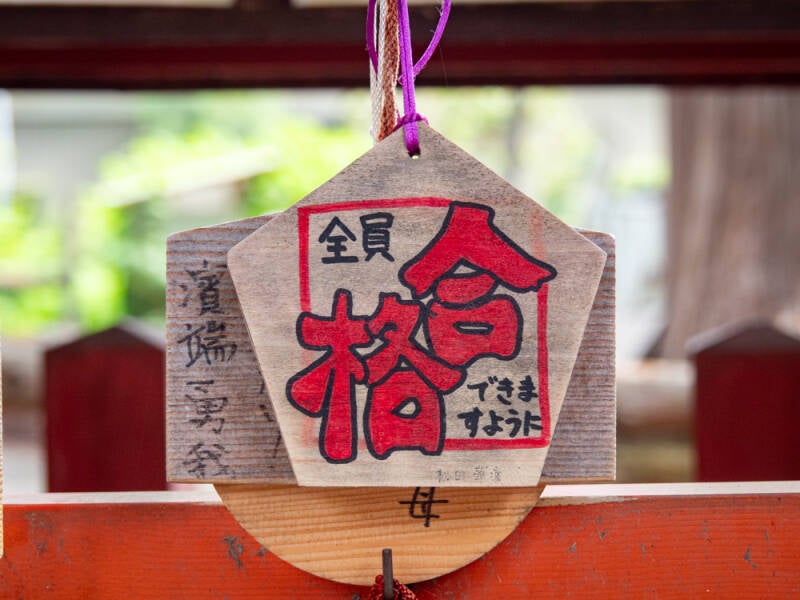
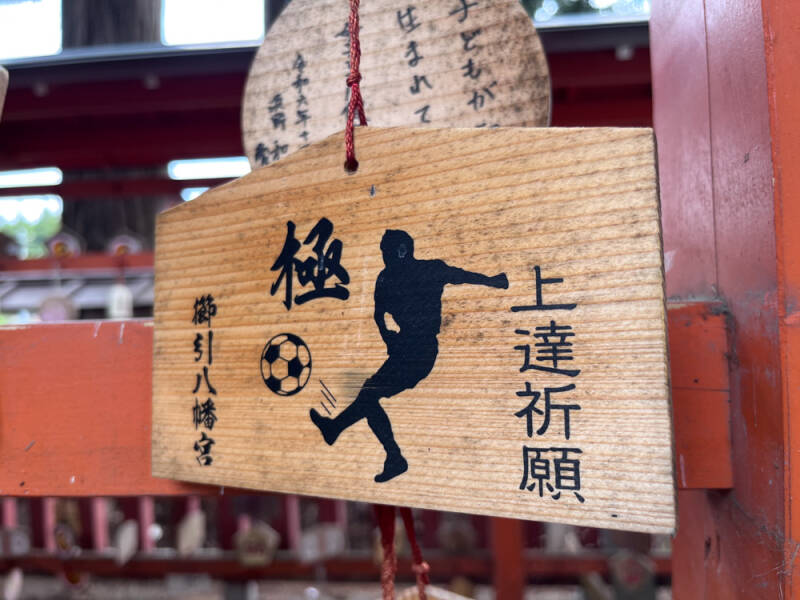


These were for sale at a local store.
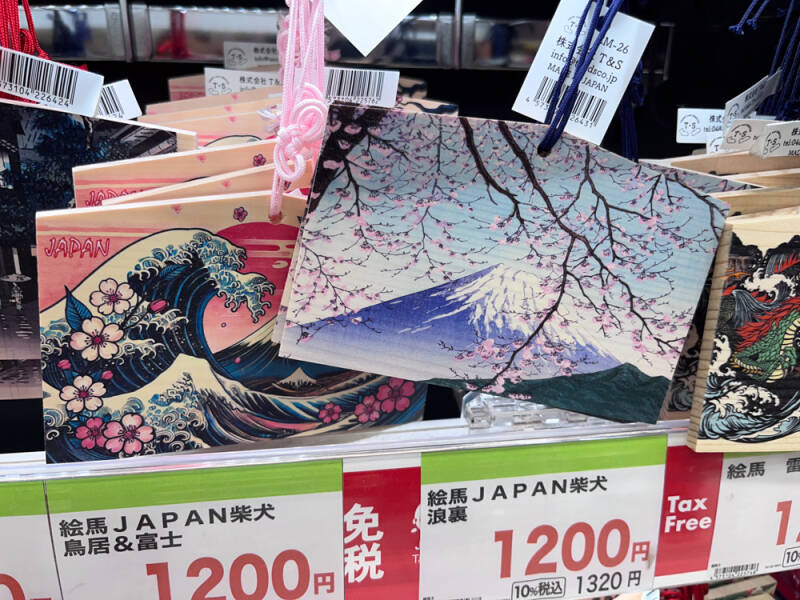


How they are generally "displayed" once purchased and before they are gathered and burned.
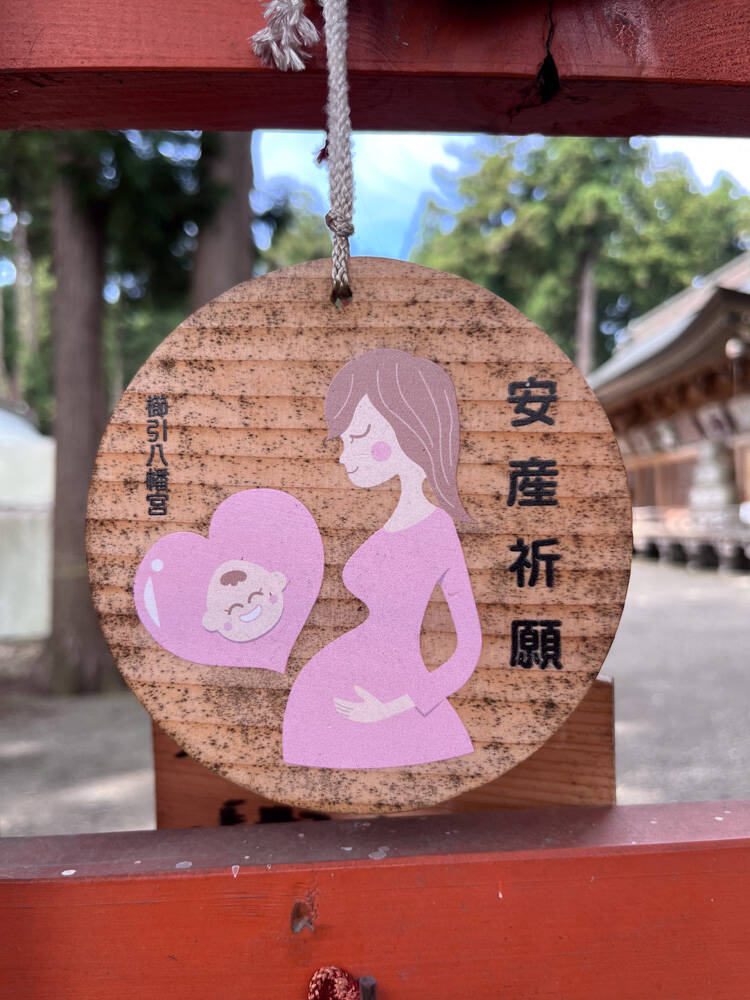
Rice Fields
In 1993, the people of Inakadate, in Aomori Prefecture, were looking for a way to revitalize their village. Archaeological exploration led to a realization that rice had been grown in the area for more than 2000 years. To honor this history, the villagers started a rice field behind the town hall. With the paddy as a canvas, the villagers cultivated and used four different types of heirloom and modern strains of rice to create a giant picture in the field. To allow viewing of the whole picture, a mock castle tower 22 meters high was erected at the village office. Twelve types of rice are now used. Before planting, artists sketch out the designs on computers to figure out where and how to plant the rice. It is a community project as they come together to plant the rice plants.
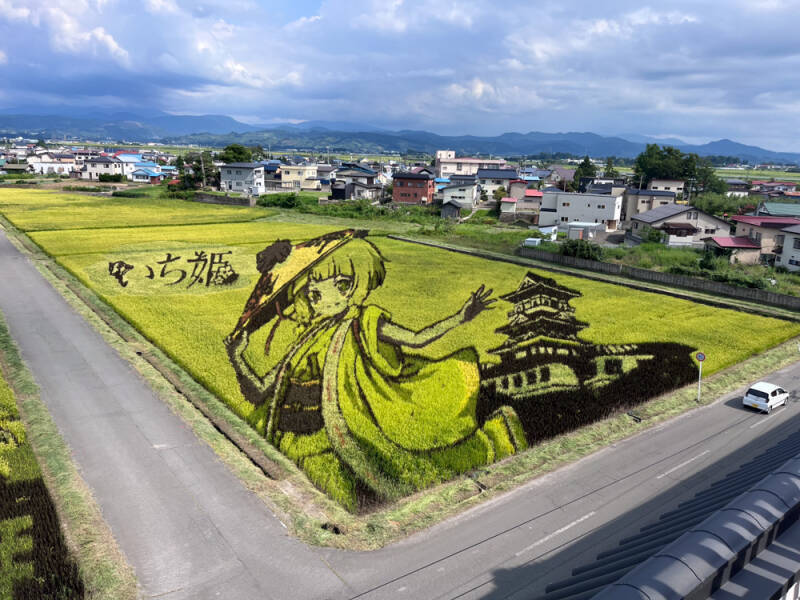


This is a portrait made with different colored pebbles.

Statues


Stone lanterns are probably not technically "statues," but we thought they were beautiful, so we included them here. They are a type of traditional East Asian lantern made of stone, wood, or metal. Originating in China, stone lanterns spread to Japan, Korea, and Vietnam, though they are most commonly found in both China and Japan in Buddhist temples and traditional gardens. In Japan, tōrō were originally used only in Buddhist temples, where they lined and illuminated paths. Lit lanterns were then considered an offering to Buddha. Their use in Shinto shrines and also private homes started during the Heian period (794–1185). The set of lanterns to the right above are in the Mausoleum of the Tokugawa Shoguns. These temple grounds house the remains of six of the 15 shoguns as well as their families.

The Towada Art Center had a WONDERFUL exhibit.

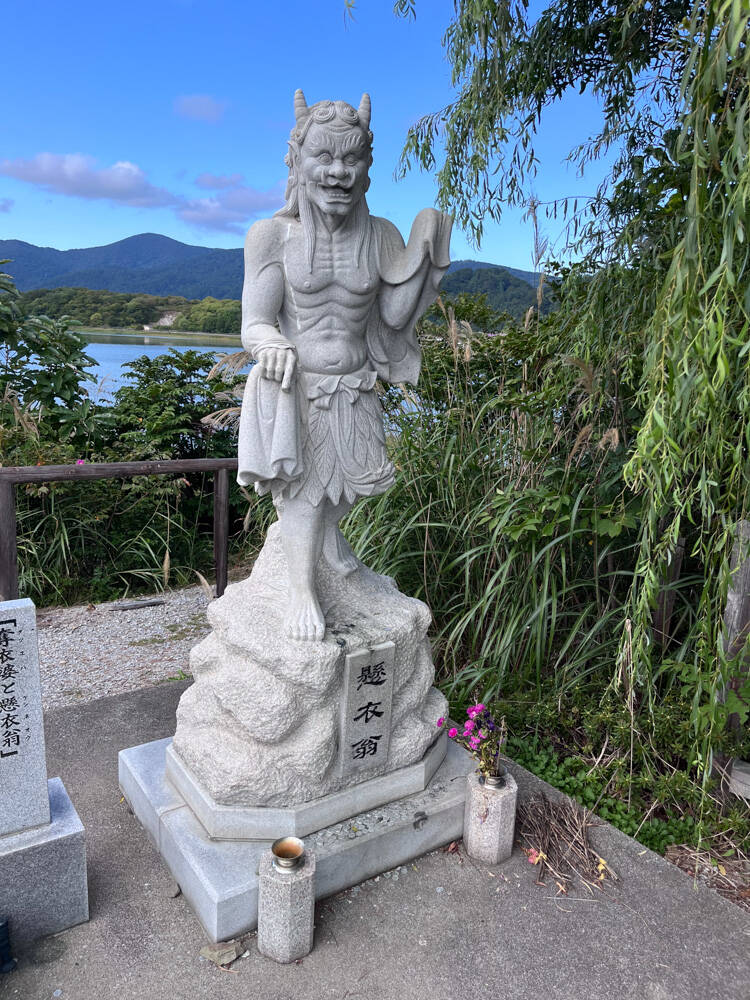
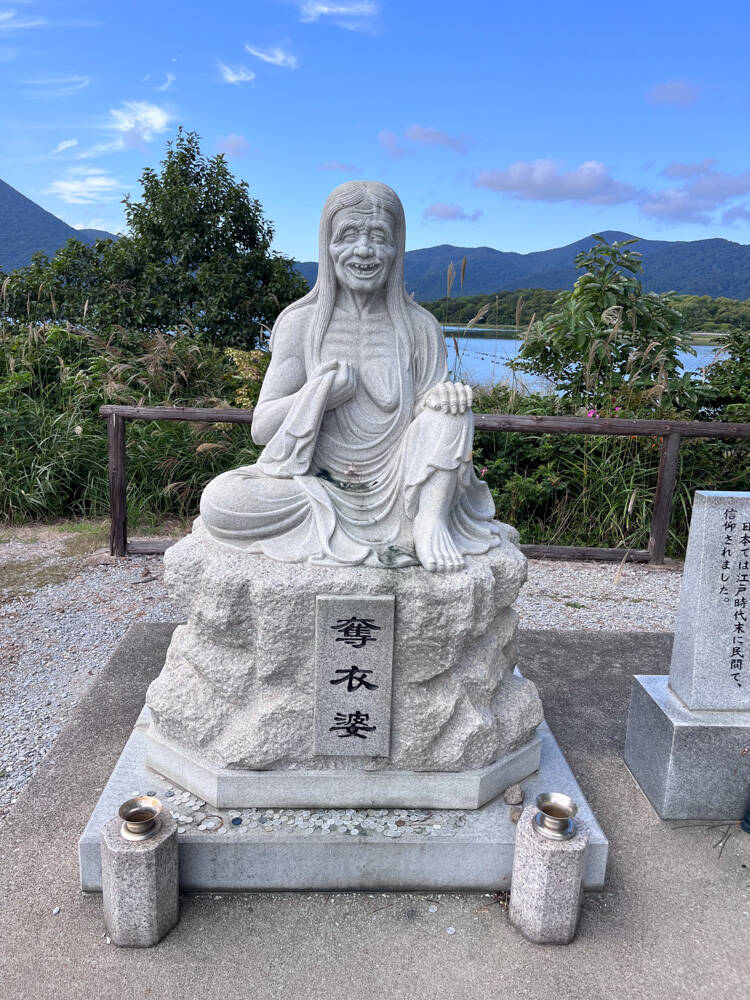
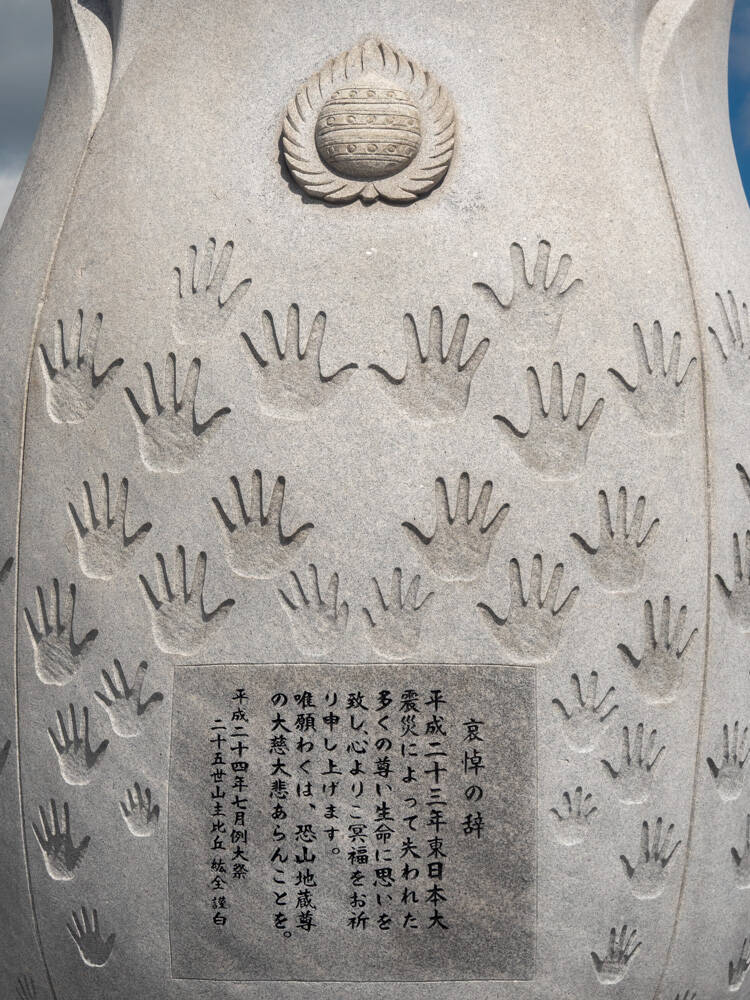
These two greet you on your way to Osorezan on the Shimokits Peninsula. It is one of the three most sacred places in Japan. This mysterious place is considered to be both hell and paradise, and as a power spot gets visited by many worshippers each year. It has been said by the locals that if you die, you will go to Osorezan. Osorezan is said to be the closest place to the other side of the world, and as a place to make offerings to and remember the dead.
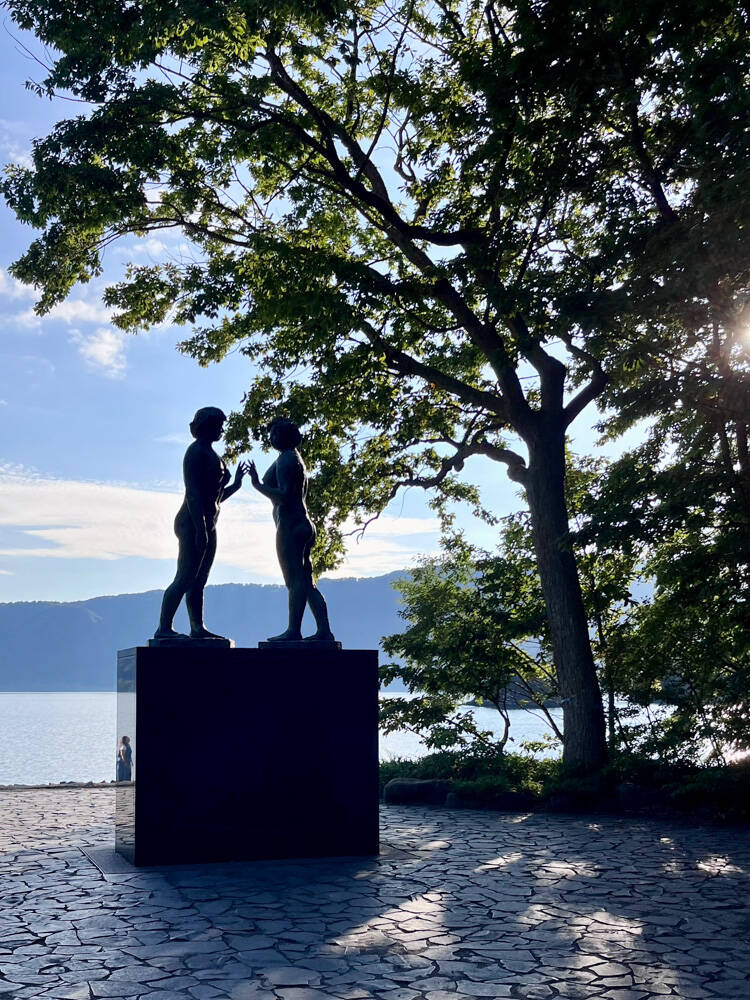
The "Maiden Statue" stands at Gozengahama Beach in Yasumiya on the shores of Lake Towada. Known as a masterpiece by the poet and sculptor Kotaro Takamura, it has become a literal symbol of Lake Towada. Kotaro once wrote, "If you're going to stand, stand silently for thousands of years." The statue was completed in the fall of 1953.

Miss Veedol was the first aeroplane to fly non-stop across the Pacific Ocean. On October 5, 1931, Clyde Pangborn and co-pilot Hugh Herndon landed in the hills of East Wenatchee, Washington, following a 41-hour flight from Sabishiro Beach, Misawa, Japan, across the northern Pacific. The flight won the pair the 1931 Harmon Trophy in recognition of the greatest achievement in flight for that year.
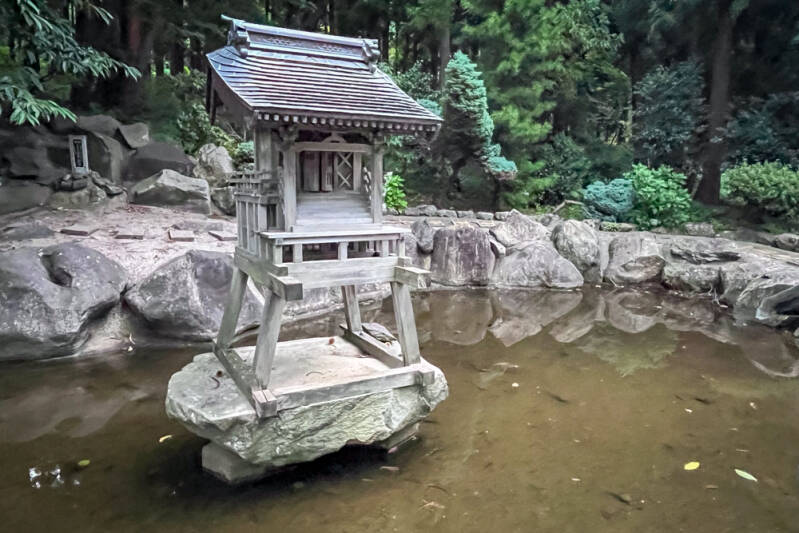
Seen on the temple grounds of the Big Buddha in Aomori City.

A group of stone carvings at the Open Air Farm House Museum in Osaka.
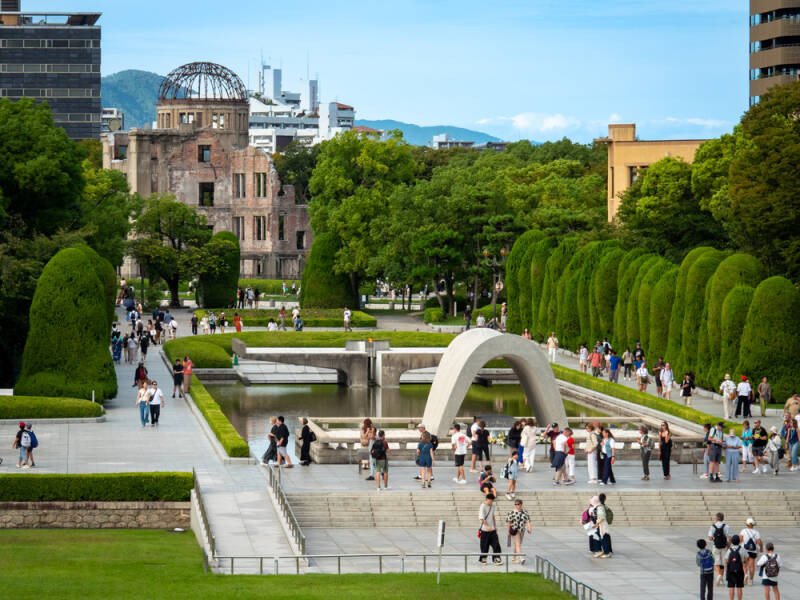
Near the center of the park is a concrete, saddle-shaped monument that covers a cenotaph holding the names of all of the people killed by the bomb. The monument is aligned to frame the Peace Flame and the A-Bomb Dome. The Memorial Cenotaph was one of the first memorial monuments built in an open field on August 6, 1952. The arch shape represents a shelter for the souls of the victims.
In the pond is the Peace Flame, another monument to the victims of the bomb, but it has an additional symbolic purpose. The flame has burned continuously since it was lit in 1964 and will remain lit until all nuclear bombs on the planet are destroyed and the planet is free from the threat of nuclear annihilation.

The Children's Peace Monument is a statue dedicated to the memory of the children who died as a result of the bombing. The statue is of a girl with outstretched arms with a folded paper crane rising above her. The statue is based on the true story of Sadako Sasaki, a young girl who died from radiation from the bomb. She is known for folding over 1,000 paper cranes in response to a Japanese legend. To this day, people (mostly children) from around the world fold cranes and send them to Hiroshima, where they are placed near the statue. The statue has a continuously replenished collection of folded cranes nearby.
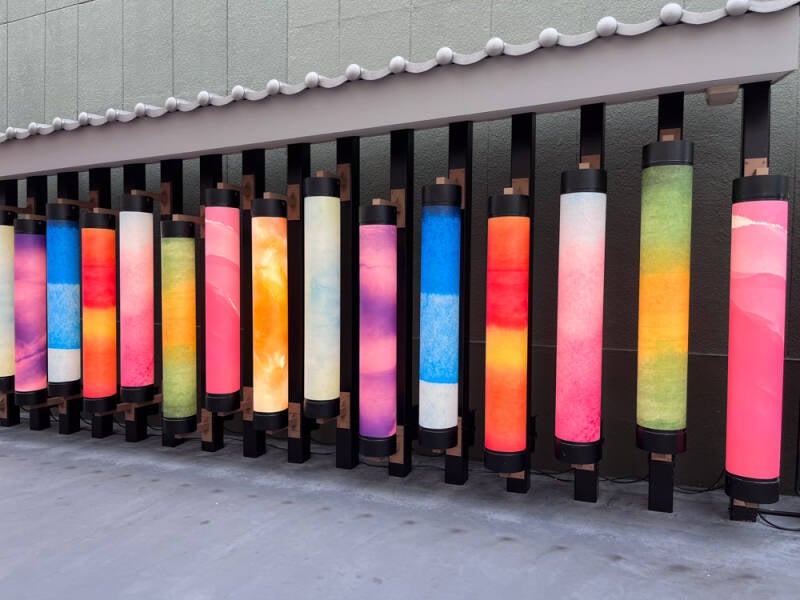
I'm not sure what these are made of, maybe cloth? Maybe plastic? Either way, they were pretty and randomly lined up on a street on our way to a large temple.
Textiles


In most thrift stores in Aomori Prececture up north one could find plenty of kimonos. They were beautiful. And at this store one could also purchase samurai armor.

We watched a whole documentary about these backpacks. Some go for as much as 75,000 yen, or $500. They are hand made using several different materials. They are ergonomic to reduce back pain. Some can be used as a "helmet" should there be an earthquake.
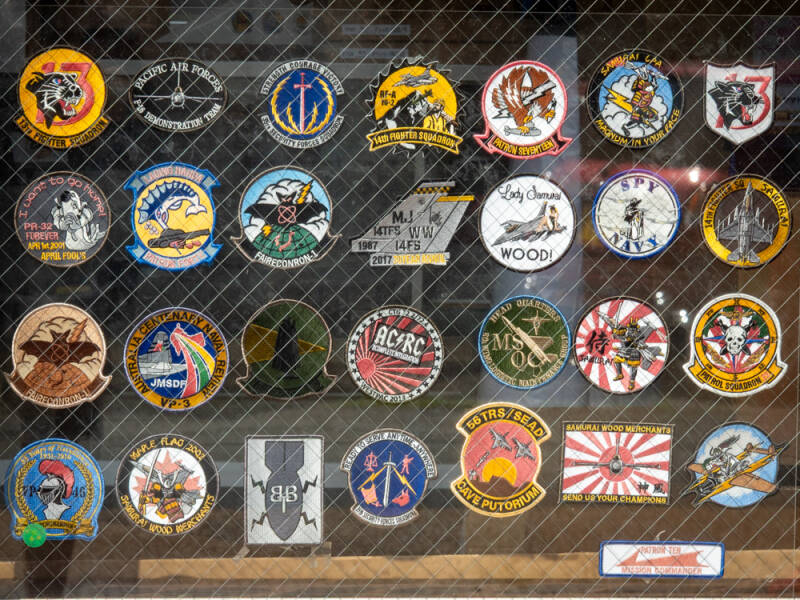

Beautiful cloth fabrics are common in doorways. These were for sale at a shop.

Found at our friend's house, these little fabric pouches can be purchased at shrines and temples, much like prayer plaques, to hold prayers, and good wishes for the recipient.
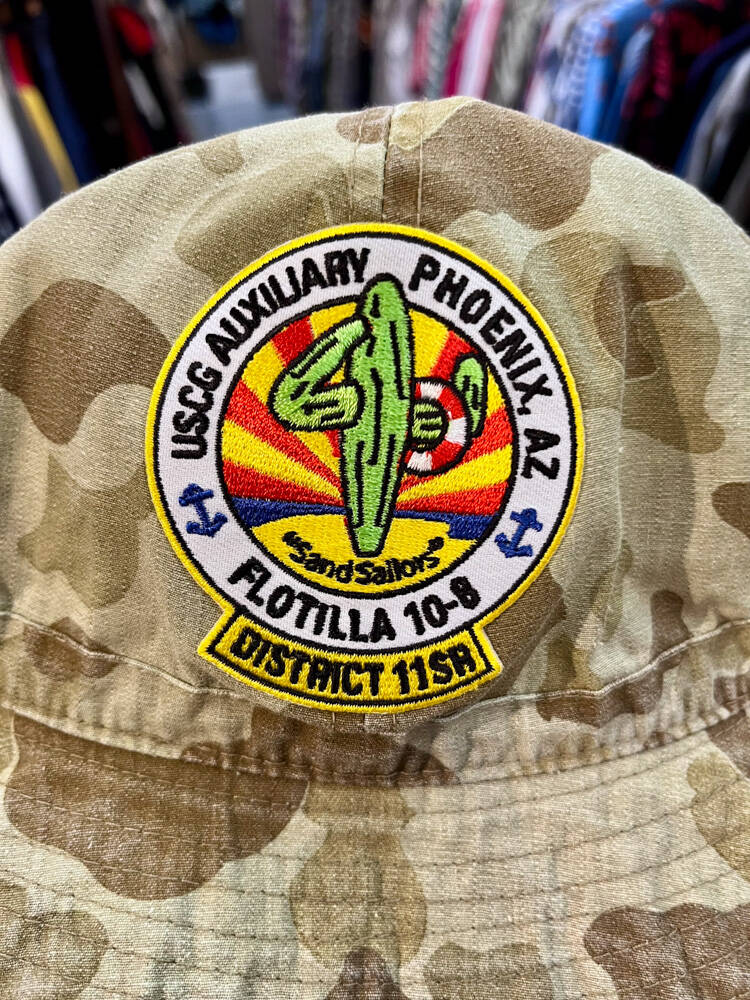
Being near an Air Force base we found a store that created unit patches. I also found this patch on a hat from Phoenix, AZ!! This one's for YOU, Jeff! Go Coast Guard!

I took this image from the bus window as we were passing two women strolling along in their kimonos. In some areas, kimono rental is very common. And it seems it comes with a photographer where you go out, get your picture taken at a beautiful temple, and return the kimono at the end of the day.
This post of course barely scratches the surface of the artistic beauty of this country. I hope you enjoyed it.
Add comment
Comments
Amazing pics! Wonderful, Bong & I must go! We’ve only seen Tokyo. ❤️
Amazing!!!!
Oh My gosh! I had time to flip through all the photos and their fun categories, but it's time to hit the road, so reading the info will come later. I can hardly wait. Love, Mamae
Well done Vicki interesting knowledge and amazing photography. Hope Ellen doesn't fall of her horse!! Keep up the good work regards Fran Xx
Amazing photos, history and information. I abstolutely loved it! Thank you for sharing!